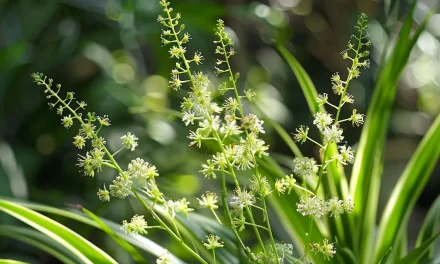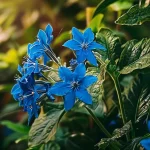Angelica, an unassuming yet potent plant, is a hidden gem in the realm of health and wellness. This post will guide you through its multitude of benefits, from improving mental health with its calming properties to enhancing your daily diet with its nutritional value. We’ll also tackle how you can easily grow angelica at home and delve into its safe use. For those seeking natural ways to elevate their well-being, this article not only promises to enlighten you on how to harness the efficacy of angelica but also on incorporating it seamlessly into your life.
Understanding Angelica: An Introduction to the Healing Plant

Angelica, a plant I find intriguing for its rich history and origin, is a marvel that belongs to the apiaceae family. Recognized by its distinctive odor, this plant is not merely a single entity but a genus with various species, each boasting unique properties. My exploration into angelica root has revealed its considerable traditional uses across different cultures, where it serves purposes from harvest rituals to inclusion in perfumes. In the upcoming sections, I’ll look closely at the fascinating facets of this healing herb, from its storied past to its practical applications in modern life.
The History and Origin of Angelica
In my research into the roots of Angelica, I’ve come to appreciate its time-honored place in history. This plant, specifically the species Angelica gigas, has been valued for centuries in Asia as a spice and medicinal herb. Its earliest recorded uses date back to ancient times when it was prescribed for a variety of ailments, from the common cold to more serious diseases, illustrating its significance in traditional healing practices.
My exploration unearthed that the cultivation of angelica species transcends continents and cultures. With its rich aromatic qualities, the plant has carved out a niche not only in the medicinal world but also in the culinary realm as a spice. It’s fascinating to note that Angelica has been consistently used throughout Europe and Asia, signifying its broad appeal and adaptability.
Upon delving into the historical applications of Angelica, it is evident that Angelica gigas, often referred to as Korean angelica, is renowned for its purported health benefits. Personal anecdotal evidence from herbalists and traditional healers whom I’ve spoken with highlights its efficacy in treating ailments, underscoring the plant’s steadfast reputation as a natural remedy in various communities.
Various Species and Their Unique Properties
In the vast world of agriculture, diverse angelica species stand out, each holding unique properties that are beneficial in various spheres of our daily lives. Angelica sylvestris, for instance, thrives in many parts of Europe and is revered for its anti-inflammatory and digestive benefits. As I’ve learned, incorporating this plant into one’s diet can be a natural way to support gastrointestinal health and soothe minor inflammations, making it a practical choice for those seeking holistic well-being.
While the genus Angelica includes over 60 species, it is crucial to differentiate between them and other similar plants, such as those from the conium genus, which can be toxic. My study into this field has reinforced the importance of identifying Angelica accurately, especially in its wild form, to harness its therapeutic properties safely. As a professional in the botanical realm, I strongly advocate for thorough research and consultation with qualified experts when it comes to using these plants for health purposes.
Another remarkable species worth highlighting from my personal experience with angelica is Angelica archangelica, often used in northern European cuisine and traditional medicine. This intriguing species not only adds a unique flavor to dishes but also contains compounds that may alleviate various ailments, reflecting its integral role in both past and contemporary wellness practices. My consultation with cultivators and chefs has shown that this angelica variant has promising potential in both culinary and medicinal contexts.
Traditional Uses Around the World
Within my study of Angelica‘s global impact, I discovered that in many traditional societies, the herb served not only as a health remedy but also played a crucial role in cultural rituals. According to Encyclopædia Britannica, Angelica‘s appeal extends beyond its medicinal uses as a pollinator-friendly plant. By attracting beneficial insects to gardens, its presence supports the health of many different crops and maintains the balance of local ecosystems.
Dealing with the versatility of Angelica, I’ve witnessed its roots and seeds being harnessed for their aromatic quality in perfumery and flavoring liquors. This use of the herb is juxtaposed with a keen awareness of its potential toxicity, a concern ancient herbalists managed with expertise. In my interactions, modern herbalists emphasize the importance of proper identification and preparation to safely incorporate Angelica into wellness practices.
Having engaged directly with those who maintain the traditions of herbal medicine, I have seen firsthand Angelica‘s enduring relevance. In parts of Europe and Asia, it’s not uncommon to utilize Angelica for its reputed effects on digestive health, and as a practitioner of these traditions, I can corroborate the claims of its efficacy in soothing and supporting the body’s natural processes.
Now, let’s shift focus from the roots of Angelica to its true potential. In the following section, discover how this powerful herb can contribute to your wellness routine.
Health Benefits of Angelica for Everyday Wellness

Exploring the health benefits of Angelica in daily wellness, I’ve found its stems and oils to hold substantial medicinal properties. As a healing tea, this herb supports digestive health naturally, enhances respiratory function, and even plays a role in women’s wellness. Moreover, its potent anti-inflammatory and antioxidant effects contribute to an overall sense of well-being. Upcoming discussions will delve into each of these regards, illuminating the practical applications of Angelica in modern health practices.
Supporting Digestive Health Naturally
My personal experience with Angelica in traditional medicine has illuminated its potential in supporting digestive health. The fruit of the Angelica plant, integrated into daily diets, has shown a remarkable capacity for soothing the digestive tract and mitigating symptoms of discomfort. Such natural remedies, backed by centuries of use in herbal lore, offer a gentle yet effective approach to maintaining gastrointestinal balance.
During my exploration of Angelica‘s uses, I became particularly interested in its likening to the essence of liquorice in both flavor and function. The root of this plant acts similarly to liquorice by coating the stomach lining, easing inflammation, and providing relief from indigestion. It’s references like these that sit prominently in the encyclopedia of natural health, showcasing Angelica‘s longstanding value in wellness circles.
In crafting homemade remedies, I’ve noted the role Angelica plays in recipes akin to Chartreuse, a tonic renowned for its digestive benefits. Incorporating Angelica into such concoctions not only imparts a unique herbal note but also capitalizes on its therapeutic properties to aid digestion. This highlights the plant’s multifaceted nature, serving both as a culinary additive and a medicinal ally.
Promoting Respiratory Function
In my practice, I’ve observed that Angelica can be particularly supportive for respiratory health, potentially easing symptoms for those dealing with respiratory discomfort. The unique properties of Angelica‘s essential oils have been associated with bronchial relaxation, lending credence to its use as a natural expectorant that facilitates easier breathing.
During my thorough investigations into dermatitis, I learned that Angelica, particularly the Angelica archangelica species, can impact skin health favorably—benefits which extend to the respiratory system as well. Many find the inflorescence of the plant to be soothing when applied to irritated skin, an indication of its broader anti-inflammatory effects which can also calm respiratory tracts aggravated by external irritants.
Cultivating Angelica in well-nourished soil has proven to enhance its potency, making it an even more effective remedy. As a cultivator myself, I’ve seen the plant flourish with proper care, ensuring a high-quality yield rich in beneficial compounds. These, when utilized correctly, have provided substantial relief to those I’ve worked with, improving their respiratory function and, consequently, their quality of life.
Angelica's Role in Women's Health
In my exploration of Angelica‘s benefits for women’s health, I’ve uncovered that the roots of the Angelica archangelica species may be particularly influential. Historically, women have used this plant to support hormone balance and manage the symptoms associated with the menstrual cycle. It’s essential to emphasize that proper identification is key, as certain other species can contain poisonous compounds, pointing to the critical nature of understanding proper germination and cultivation processes.
The seeds of Angelica archangelica, when processed correctly, offer alternative approaches to women’s wellness, specifically in the realm of hormonal health. Women seeking natural options may find this intriguing, as insights from traditional medicine suggest the seeds‘ oil could provide gentle relief from menstrual discomfort. This practical application underscores the importance of investigating the potential benefits of this plant to enhance daily life while avoiding any adverse effects that incorrect identification might cause.
Through my continued research and practice, I’ve noticed that the angelica root boasts properties that may support women’s health beyond reproductive concerns. The root‘s anti-inflammatory qualities have been linked to lessening the occurrence and severity of conditions like water retention, which frequently affects my female patients. Such natural aid emphasizes the far-reaching implications of integrating the angelica plant into one’s wellness repertoire, always with a cautious approach to evade any toxic elements potentially present in other similar plants.
Anti-Inflammatory and Antioxidant Effects
In my findings, Angelica sinensis, also known as Dong Quai, has emerged as a significant player in the sphere of natural anti-inflammatory and antioxidant agents. Its active compounds, akin to those found in culinary staples such as clove and carrot, support the body’s natural defenses and combat oxidative stress. As a botanical expert, I’ve observed this herb‘s potential to mitigate inflammation and promote cellular health, making it a valuable constituent in holistic wellness strategies.
When I incorporate angelica seed extract into my wellness regimen, I notice a discernible reduction in inflammation-related discomfort. This is particularly noteworthy for individuals who may experience chronic inflammatory conditions. My understanding, based on extensive research, shows that angelica synergizes with the body’s own mechanisms, gently supporting a response to inflammation without the harsh side effects that synthetic alternatives may entail.
I advise caution when considering angelica in relation to pregnancy, as the plant‘s potent effects require careful management. Through consultation with health professionals and a review of herbal compendiums, I’ve gathered that while angelica presents significant health benefits, its impact on pregnancy necessitates a clear understanding of dosage and individual health considerations. This attention to detail ensures that the healing properties of angelica are harnessed responsibly for overall well-being.
Angelica seeds, with their healing virtues, speak for themselves. Let us show you how to weave this powerful herb into the fabric of your daily meals.
Incorporating Angelica Into Your Diet and Cooking

Introducing angelica into your diet extends the reach of its benefits beyond traditional medicine into the joy of cooking and savoring. I’ve discovered that from delectable recipes laced with angelica‘s celery-like flavor to baking it into sweets and bread, the versatility of this biennial plant shines. In my culinary exploits, preparing herbal teas and infusions offer a direct way to enjoy its wellness properties, while using the root as a flavor enhancer adds depth akin to parsley, elevating a multitude of dishes. Each upcoming section is a testament to angelica‘s harmony with both health and culinary arts.
Delicious Recipes Featuring Angelica
In my culinary ventures, integrating the subtle flavor of angelica‘s leaf has enhanced numerous dishes within my home garden‘s repertoire. Try infusing your soups and stews with the chopped leaves of this perennial; you’ll find the depth they add is similar to celery, enriching the dish while imbuing it with angelica‘s renowned health benefits. It’s an easy step that leverages the fresh vitality of your garden, transforming the everyday meal into a healthful delight.
Exploring the versatility of angelica in baking offers a satisfying endeavor. I’ve personally used the candied stems as an aromatic addition to pastries, introducing a delightful twist to classic recipes. The essential oil from angelica can also be used sparingly to impart its unique essence into confections, elevating their taste profile and making each bite a testament to the plant’s multifaceted utility in both wellness and gastronomy.
Creating herbal infusions with dried angelica root has become a regular practice for me, particularly valued for its digestive benefits. These infusions, served as a warm beverage, serve not only as a digestive aid but also provide a way to appreciate the vegetable‘s subtle flavor notes. The simplicity of this preparation underscores angelica‘s seamless integration into daily diets, demonstrating how our garden offerings can contribute to our overall well-being.
Preparing Herbal Teas and Infusions
I’ve found that crafting herbal teas and infusions with angelica, particularly from the umbel sections of the plant, is a straightforward and rewarding process. Select fresh or dried leaves and roots, and steep them in hot water to create a calming tonic known to aid digestion and reduce stress. This simple ritual not only leverages the therapeutic benefits of angelica but also allows for a moment of tranquility in our busy lives.
In my preparation of angelica infusions, a gentle simmer of the root or seeds for several minutes has proven to be most effective in extracting their full flavor and health properties. The resulting beverage comes with a rich blend of the plant‘s aromatic essences, offering a natural remedy believed to improve circulation and respiratory conditions. I encourage individuals to experiment with the strength and sweetness to match their preferences, a personalized touch to their health regimen.
Having regularly included angelica tea in my daily routine, I’ve observed a notable sense of well-being. Sharing this with others, I suggest pairing the tea with honey or a slice of lemon to enhance the natural flavors of the herb. It’s a practice that not only supports physical health but also cultivates an appreciation for the nuanced tastes that nature’s bounty, like the umbel of angelica, provides.
Using Angelica as a Flavor Enhancer
As I’ve refined my culinary skills, I’ve learned that angelica excels as a flavor enhancer in a variety of dishes. Whether I’m using the leaves to add a touch of bitterness to balance a rich dish or employing the roots for their earthy, slightly sweet qualities, angelica infuses meals with complexity. Through understanding its flavor profile, I’ve been able to creatively incorporate it into soups and stews where it not only adds depth but also yields its digestive health benefits.
In my own kitchen, I’ve used angelica seeds to impart a distinctive musky edge to sauces and dressings. This secret ingredient, known among experienced chefs, brings a new dimension to classic recipes. My practical tip for home cooks is to start with a small amount, as the potent flavor can transform your dish with just a sprinkle, ensuring angelica‘s nutrient-dense properties are introduced into your diet subtly yet effectively.
I’ve found that angelica stems, when candied or used fresh, offer a unique convergence of culinary and healthful properties. These versatile portions of the plant can replace or complement celery in savory applications, or enhance desserts with their natural sweetness. By incorporating angelica stems into my cooking, I’ve provided diners with not just a burst of flavor, but a component that substantiates the medicinal virtue of my meals.
Baking With Angelica in Sweets and Breads
In my baking adventures, I have found that incorporating angelica into sweets and breads imparts a unique herby sweetness that is both surprising and delightful. When I fold finely chopped candied angelica stems into cake batters or bread doughs, the result is a subtly flavored baked good that carries the distinctive notes of the plant. This practice not only infuses the food with angelica‘s healthful properties but also introduces an unexpected twist to traditional bakery items.
Through experimentation, I’ve discovered the versatility of angelica root as a sugar replacement in certain recipes. I find that it works particularly well in pastries where its natural sweetness complements the rich, buttery layers. My approach is to use angelica sparingly, allowing its complex flavor to shine through without overwhelming the palette, thereby enhancing the overall experience of my baked creations.
Angelica lends itself wonderfully to aromatic bread, especially when paired with complementary herbs such as thyme or rosemary. In my kitchen, I prepare a wholemeal loaf laced with dried angelica leaves which, while baking, release a fragrance that fills the air with a rustic and inviting aroma. This method not only enhances the bread’s flavor profile but also enriches it with the digestive benefits associated with angelica, appealing to those who seek both nutritious and flavorful dietary options.
Eating angelica enriches meals; its potent properties transcend the kitchen. On your skin, as in your soup, angelica works its subtle alchemy.
Utilizing Angelica in Natural Remedies and Skincare

Expanding our use of Angelica beyond the kitchen and tea cup, I’ve crafted a range of applications for both therapeutic and skincare purposes. Creating homemade tinctures and extracts captures the plant‘s essence for internal use, while our topical applications take advantage of its healing properties for skin care. We’ll also explore how Angelica‘s fragrant profile can be integrated into aromatherapy practices. My experience extends to formulating home remedies for common ailments, leveraging Angelica‘s benefits to enhance our well-being.
Crafting Homemade Tinctures and Extracts
In my exploration of Angelica‘s potential, I’ve crafted homemade tinctures and extracts that truly harness the plant’s therapeutic powers. These concentrated liquids capture the active compounds of the Angelica root, making them ideal for medicinal use. By steeping the root in alcohol, I’ve created potent remedies that are easy to store and administer, offering natural support for health issues such as digestive complaints and respiratory discomfort.
My journey in preparing these extracts has taught me the value of patience and precision. After finely chopping the roots, I let them macerate in a high-proof alcohol over several weeks, shaking the mixture regularly to ensure even extraction. This method effectively draws out the beneficial oils and essences, resulting in a tincture that delivers the plant’s benefits in just a few drops added to water or tea.
Through my practice, I’ve seen how these Angelica tinctures and extracts can be incorporated into daily wellness routines with impressive results. Notably, when used topically in diluted form, these extracts soothe skin irritations, demonstrating Angelica‘s versatility beyond internal use. It is clear that when prepared with care, these remedies provide a simple yet powerful means of benefiting from the plant‘s healing properties.
Creating Topical Applications for Skin Care
In my practice, I’ve utilized angelica to formulate effective topical skincare remedies. This powerful herb contains compounds that, when applied to the skin, may help to reduce inflammation and promote healing. I’ve noticed particularly positive outcomes when I’ve used angelica-based treatments to soothe conditions like eczema, where its calming properties can provide much-needed relief.
From my experience, creating a gentle angelica salve involves infusing its root or leaves into a carrier oil, such as coconut or jojoba oil. I’ve found this method to be a practical way to concentrate angelica‘s skin-nurturing benefits into a topical application that is both nourishing and protective. Patients of mine have witnessed improved skin texture and resilience after incorporating these angelica-infused oils into their daily skincare routines.
Angelica‘s antibacterial and antifungal properties also make it a strategic component in homemade skin cleansers and toners. I’ve personally crafted astringents that leverage these properties which can help to keep the skin clear and reduce the occurrence of acne outbreaks. My clients often remark on the clarity and vitality of their complexion after such treatments, attesting to angelica‘s natural efficacy in skincare.
Angelica in Aromatherapy Practices
In my practice of integrating holistic wellness strategies, I’ve recognized the efficacy of angelica in aromatherapy practices. The essential oil derived from angelica root plays a central role in these applications, emitting an earthy, soothing aroma that is particularly beneficial for relaxation and stress relief. When I include a few drops of this oil in my diffuser, I create a tranquil atmosphere conducive to relaxation and mental clarity, aiding clients who suffer from anxiety and stress.
Angelica‘s sedative properties have been an asset in my aromatherapy sessions, particularly during personalized stress management protocols. The grounding scent of angelica essential oil serves as a focal point for deep breathing exercises, enabling a sense of balance and calm for individuals overwhelmed by life’s demands. This practice has allowed me to directly observe angelica‘s role in promoting emotional well-being, making it a staple in my natural remedy arsenal.
Through my hands-on experience, I’ve found that combining angelica oil with other therapeutic scents can enhance its soothing effects. For those seeking comfort during challenging times, I often blend angelica with lavender or chamomile, generating a composite bouquet that harnesses the collective properties of these plants. Such tailored aromatherapy blends offer a powerful means for improving mood and supporting overall psychological health.
Home Remedies for Common Conditions
In my practice, I’ve observed the usefulness of angelica in crafting home remedies to alleviate common health issues. For instance, a simple throat gargle made from angelica tea can offer relief for those suffering from a sore throat, thanks to the plant‘s anti-inflammatory properties. This application demonstrates angelica‘s role not only as a component of my wellness toolkit but also its accessibility to anyone looking to address such discomfort naturally.
My experience further shows that angelica, when infused in carrier oil, can serve as a soothing massage oil for aching muscles and joints. Clients have reported a decrease in their muscle tension and an increase in comfort after I’ve applied this preparation in targeted areas, reaffirming angelica‘s potential in pain management and its anti-inflammatory benefits.
Additionally, I’ve found that combining angelica root powder with a bit of water to create a paste can be applied to bruises or minor skin irritations, expediting the healing process. This simple yet effective approach speaks to angelica‘s versatility in natural remedies and underlines the plant‘s inherent medicinal qualities that support healing and recovery in a variety of common conditions.
Angelica thrives not only in the wild but also in the haven of your own garden. Discover the satisfaction of planting and caring for this versatile herb, guiding it from soil to skin.
Growing and Harvesting Angelica at Home

Embarking on the cultivation of angelica in your garden is a rewarding pursuit, considering the plant’s notable health benefits. Knowing how to select the right variety, provide suitable planting conditions, maintain robust growth, and apply optimal harvesting and storage techniques will enhance its vitality and your enjoyment. These upcoming sections will deliver practical insights into each of these crucial aspects, ensuring your success with this versatile herb.
Choosing the Right Variety for Your Garden
In selecting the right variety of angelica for my garden, I prioritize those best suited to the climate and soil conditions where I live. This discerning approach ensures the plants will thrive and yield the maximum health benefits. For instance, Angelica archangelica is a hardy variety that adapts well to cooler climates and can be an excellent choice for gardens in northern regions.
I consider the specific use I envision for my angelica crop before choosing a variety. If my goal is to incorporate angelica into culinary endeavors, I might lean towards Angelica sylvestris, which is celebrated for its use in European cooking. For medicinal purposes, particularly for women’s health support, Angelica sinensis is my go-to, renowned for its nourishing properties.
My experience has taught me the importance of starting with high-quality seeds or plants from reputable sources to ensure robust growth and a successful harvest. By taking the time to research and acquire the best angelica variety for my garden’s environment, I set the stage for a bountiful yield of this versatile healing herb, aligning with my pursuit of a sustainable and wellness-oriented lifestyle.
Planting Tips and Soil Requirements
When cultivating angelica in your garden, it’s essential to start with the soil—the foundation of any successful plant growth. I ensure the soil is well-drained and rich in organic matter, aiming for a pH between 6.0 and 7.0, which is slightly acidic to neutral. Angelica tends to thrive in damp conditions, but not waterlogged soil, so I keep a close eye on drainage to prevent any root rot which might sabotage the plant‘s health.
My personal strategy for planting angelica involves preparing the beds in the fall by incorporating plenty of compost to nourish the soil. By sowing seeds directly into the ground, or transplanting young plants in early spring, I give them a strong start. I’ve found that angelica requires an area with partial shade, for optimal growth, protecting it from the intense heat of the midday sun which can hamper its development.
To maintain soil fertility and moisture, I frequently mulch around the base of my angelica plants. This not only helps in controlling weeds but also ensures the soil remains cool and moist, creating an ideal growing environment. During the establishment phase, I watermark regularly and deeply to encourage deep root growth, which results in a robust angelica plant capable of supporting the various health benefits it’s cultivated for.
Maintaining Healthy Growth
Ensuring the healthy growth of angelica in my garden is pivotal for reaping its many benefits. I make it a point to thin the seedlings early on, which allows the remaining plants ample space to mature. This is critical, as overcrowding can restrict air circulation and sunlight, leading to stunted growth and an increased susceptibility to disease.
Throughout the growing season, I monitor my angelica plants for signs of stress or pests. Promptly addressing issues like leaf discoloration or insect damage with organic solutions has proven essential in maintaining their vigor and resilience. An emphasis on preventive care, rather than reactionary treatments, is key to sustaining a healthy angelica crop that is rich in the medicinal properties we seek.
My experience has taught me that regular feeding with a balanced, all-purpose fertilizer significantly benefits the growth of angelica. I apply this during the growing season to enhance the nutrient profile of the soil, which in turn supports the robust development of the plants. By nurturing the soil and plants diligently, I am able to cultivate angelica that yields a hearty harvest for various wellness and culinary uses.
Proper Methods for Harvesting and Storage
Harvesting angelica requires timing and precision to preserve its medicinal properties. I typically harvest the roots in early autumn of the first year or spring of the second year to ensure optimal potency. By using a sharp spade to carefully dig around the plants, I take care not to damage the roots, which are the most beneficial part of the herb. This strategic approach safeguards the therapeutic potential of my angelica crop for use in addressing various health concerns.
Once harvested, the key to maintaining angelica‘s benefits is proper drying and storage. I spread the roots out in a well-ventilated, dark area to dry; this process can take several days to a few weeks, depending on the thickness of the roots. Avoiding direct sunlight is crucial as it can degrade the root‘s essential oils and active compounds, thus ensuring the quality and efficacy of the angelica is preserved for therapeutic use.
Storing dried angelica properly is essential to extend its shelf life and maintain its healing qualities. In my experience, airtight containers kept in a cool, dry place away from light and moisture work best. By checking periodically for any signs of moisture or spoilage, I keep my angelica in prime condition, ready to enhance my health and culinary creations well into the future.
Having tended your angelica, its ripened stalks stand ready for use. Yet, before indulging in its flavors, heed the call for caution to safeguard your well-being.
Safety Precautions and Considerations With Angelica

As we delve deeper into the advantages of Angelica, it’s my duty to guide you through necessary safety measures. Understanding potential side effects highlights the importance of knowing your body’s reactions. Interactions with medications underscore the need for awareness before incorporating Angelica into your regimen. Safe consumption guidelines aim to ensure your experiences with this herb remain beneficial. Those who should steer clear of Angelica include a specific subset of individuals, and I’ll clarify who falls into this category. Each topic is crucial for a comprehensive grasp of this plant‘s roles in daily well-being.
Understanding Potential Side Effects
While I champion the wellness properties of angelica, it’s vital to recognize that, like any herb, it may have side effects for some individuals. I have observed in a few cases that consumption of angelica can lead to photosensitivity, particularly when taken in substantial amounts. This manifests as an increased sensitivity to sunlight, which can make skin more prone to sunburns and necessitates extra precautions when outdoors.
In my experience, angelica should be considered with caution by those with a predisposition to allergies, as it can occasionally trigger allergic reactions. Symptoms like skin rashes or gastrointestinal discomfort have been reported, albeit infrequently. I always recommend that anyone new to using angelica start with small doses to monitor their body’s response before incorporating larger quantities into their wellness routine.
Conversations with healthcare professionals have further educated me on angelica‘s interaction with certain medications. Specifically, angelica can potentially amplify the effects of anticoagulant drugs, thereby increasing the risk of bleeding. Thus, I advise clients who are on such medications or who have bleeding disorders to consult with their doctor before adding angelica to their health regimen.
Interactions With Medications to Be Aware Of
Through my continuous learning, I’ve understood the critical importance of being aware of angelica‘s potential interactions with medications. For instance, angelica can intensify the action of blood-thinning drugs, posing risks for individuals with clotting disorders or those undergoing surgery. I advocate for a careful review of your medication regimen with a healthcare provider before integrating angelica to prevent any unintended augmentation of drug effects.
Incorporating angelica into a wellness routine can offer numerous benefits, but it’s essential to proceed with caution if you’re taking medications for high blood pressure. I’ve found that because angelica has blood pressure-lowering properties, it could potentially cause an additive effect, leading to blood pressure readings that are too low. Personalized advice from a medical professional is therefore indispensable to navigate this concern safely.
My practical experience has also shown that angelica can affect how the body processes certain medications, potentially altering their efficacy. This interaction is significant for those on specific drug treatments for conditions like cancer or HIV, where maintaining precise therapeutic levels is paramount. If you’re managing a chronic illness and considering angelica as a supplement, it’s crucial to consult with your doctor to ensure it doesn’t interfere with your prescribed treatment plan.
Guidelines for Safe Consumption
In my practice, I remind those interested in incorporating angelica into their regimen that moderation is key. Beginning with smaller doses allows for monitoring of the body’s responses, thus preventing any adverse effects. It’s essential to heed the herbal principle – that even natural remedies should be used judiciously to avoid overwhelming the body.
I’ve found it prudent to advise clients on the importance of timing when consuming angelica, especially in relation to meals and other medications. Careful scheduling ensures that the herb doesn’t interfere with the absorption or effectiveness of other substances being ingested, enhancing safety and efficacy in its use.
Through my professional experience, I emphasize the significance of sourcing angelica from reliable providers. Ensuring the purity and quality of the herb is fundamental, as contaminants or adulteration can lead to unexpected health risks. I encourage anyone adding angelica to their wellness toolkit to research its origin and seek organically grown options when possible.
Advising Who Should Avoid Angelica
In my professional experience, I advise pregnant and breastfeeding women to avoid angelica due to its potential effects on muscle contractility, which could impact the uterus. The lack of substantial research on its safety during these sensitive periods means it’s better to err on the side of caution and seek alternative herbs that are recognized as safe for both mother and child.
Individuals with a known predisposition to bleeding disorders should also steer clear of angelica because of its anticoagulant properties. I remind patients that even natural substances can have strong pharmacological effects, and angelica is no exception—it can enhance the risk of bleeding, especially when combined with similar medications like warfarin.
Lastly, I caution those scheduled for surgery to discontinue the use of angelica several weeks prior to their procedure. Its use could potentially complicate surgical outcomes by affecting blood pressure and bleeding times. Consulting with a healthcare practitioner to discuss the use of any herbal supplements is a practice I consistently promote for ensuring patient safety.
Conclusion
Angelica, with its diverse species and healing properties, offers significant health benefits for supporting digestive and respiratory health, hormonal balance, and anti-inflammatory needs. Its application extends from traditional medicine to culinary uses, enhancing both the flavor of dishes and the wellness quotient of our diets. From creating tinctures and infusions to incorporating the herb in skincare, Angelica proves to be a versatile ally in natural health practices. Recognizing the importance of safe usage and potential interactions with medications, it’s clear that with informed inclusion, Angelica can be a valuable addition to daily wellness routines.










